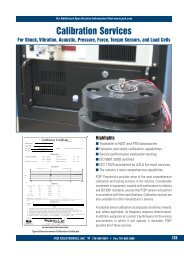High Temperature Accelerometers - Synotech Sensor und
High Temperature Accelerometers - Synotech Sensor und
High Temperature Accelerometers - Synotech Sensor und
Create successful ePaper yourself
Turn your PDF publications into a flip-book with our unique Google optimized e-Paper software.
<strong>High</strong> <strong>Temperature</strong> <strong>Accelerometers</strong>Technical SpecificationsModel Number EX600B13 [7][8][9][10] EX600B14 [7][8][9][10]PerformanceSensitivity (± 5 %)100 mV/g 10 mV/g10.2 mV/(m/s²) [2] 1.0 mV/(m/s 2 ) [2]Measurement Range± 50 g pk ± 500 g pk± 490 m/s² pk ± 4,900 m/s² pkFrequency Range (± 5 %)282 to 210,000 cpm4.7 Hz to 3.5 kHz [3] [4]Frequency Range (± 10 %)204 to 300,000 cpm3.4 Hz to 5 kHzResonant Frequency1,200 kcpm20 kHz [1]Broadband Resolution (1 to 10 kHz) 450 µg 4,415 µm/sec 2 [2]Non-linearity (per full scale range) ≤ 1 % [5]Transverse Sensitivity ≤ 5 %EnvironmentalOverload Limit (Shock)± 1,000 g pk± 9,810 m/s² pk [2]<strong>Temperature</strong> Range(Accelerometer)<strong>Temperature</strong> Range(Charge Amplifier)-65 to 900 °F-54 to 482 °C-60 to 250 °F-51 to 121 °CBase Strain Sensitivity ≤ 0.006 g/µε ≤ 0.06 (m/s²)/µε [2]ElectricalSettling Time(@ 70 ºF within 1% bias)≤ 1.0 secDischarge Time Constant≥ .10 secExcitation Voltage22 to 28 VDCConstant Current Excitation2.2 to 20 mAOutput Impedance 10 8 ohmPhysical1.5 in x 0.75 inSize (Diameter x Height)38.1 mm x19.1 mm9.5 ozWeight (without cable)270 gmElectrical Connector2-pin MIL-C-501510 ftCable Length3 mCable TypeIntegral HardlineMounting Through Holes (3)Supplied AccessoriesModel 081A99 Cap Screw (3)Model ICS-1 NIST-traceable single-axis amplitude responsecalibration from 600 cpm (10 Hz) to upper 5% frequency (1)NotesAll specifications are at room temperature unless otherwise specified[1] Typical[2] Conversion Factor 1g = 9.81 m/s²[3] 1Hz = 60 cpm (cycles per minute)[4] The high frequency tolerance is accuratewithin ±10% of the specified frequency.[5] Zero-based, least-squares,straight line method[6] For CE reference PCB ® Declaration ofConformance PS023 for detailsG[7] Class I, Div. 1, Groups A, B, C and D; Class II,Div. 1, Groups E, F and G; Class III, Div. 1[8] Class I, Div. 1, Groups A, B, C, D[9] Ex ia IIC T4[10] Ex nL IIC T1, II 3Single Ended vs. Differential OutputMany operating engine environments generate temperaturesin excess of 288 ºC. Above this temperature, many of thedesign features and materials used in high temperatureaccelerometers change considerably. For 288 ºC to 650 ºCoperating environments, PCB ® offers a range of both singleended output (measurement output as a signal and gro<strong>und</strong>)and differential output (measurement output as a plus andminus signal) sensors. The former tend to be smaller andmore suitable for short term testing needs, while the latterare more appropriate for long term monitoring applications.Obviously, the environments in which these sensors operateare challenging. In fact, in some of the highest temperatureoperating environments, the operating sensor measuresvibration signatures while glowing red hot. These sensorsare complemented by both lab grade and in-line chargeamplifier systems. This differential charge amplifier issuitable for interfacing to any of PCB’s differential chargeoutput accelerometers.Accessories & Cables: Pages 146 - 159















